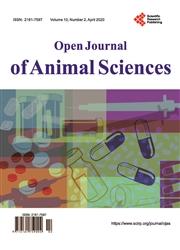Hygienic Production Practices and Microbial Quality of Cow Milk in Cheha District of Gurage Zone, Southern Ethiopia
引用次数: 1
Abstract
The aim of the study was to assess hygienic production practices and to evaluate microbial quality of raw cows’ milk in Cheha district of Gurage Zone, Southern Ethiopia. The study was conducted by interviewing 180 smallholder milk producers from two agro-ecologies (highland and midland) and by collecting 40 milk samples from milk producers, small shops, cafes and consumers for microbial quality analysis. The result indicated that majority of the respondents (96.7%) did not have cow barn and milking area, 57.3% of them clean their barn once and more than once a week. Moreover, milking without hand washing, absence of udder washing, failure to use towel to clean the udder, and use of plastic pail as milking equipment were practiced by 33.9%, 52.2%, 74.4% and 95.6% of the respondents, respectively. Furthermore, higher number of respondents (69.4%) used river water without proper treatment as a major source of water for cleaning purpose and majority of them fail to regularly clean utensils with detergents. Concerning microbial quality, overall mean total bacterial counts (TBC), Coliform counts (CC) and pH values of milk from current finding were 5.675 ± 0.016, 4.414 ± 0.017 log10 cfu/ml, and 5.963 ± 0.081, respectively. In general, overall quality of milk produced as well as marketed in the study area was poor. These were justified from poor hygienic practices and high values of TBC and CC that were significantly higher than the acceptable limits set by Ethiopian Standards for unpasteurized milk. Therefore, adequate sanitary and control measures should be taken at all stages from production to consumer level to produce and supply wholesome milk.埃塞俄比亚南部古拉格区切哈地区牛奶卫生生产规范和微生物质量
该研究的目的是评估埃塞俄比亚南部古拉格区Cheha地区生牛奶的卫生生产实践和微生物质量。研究人员采访了来自两个农业生态区(高地和中部)的180名小农奶生产者,并从奶生产者、小商店、咖啡馆和消费者那里收集了40份牛奶样本,用于微生物质量分析。结果表明,绝大多数(96.7%)的调查对象没有牛棚和挤奶区,57.3%的调查对象每周清理牛棚一次及以上。不洗手挤奶、不洗乳房、不使用毛巾清洁乳房、使用塑料桶作为挤奶设备的比例分别为33.9%、52.2%、74.4%和95.6%。此外,较多受访者(69.4%)使用未经适当处理的河水作为主要清洁水源,而大部分受访者没有定期用清洁剂清洁餐具。微生物质量方面,本次检测的牛奶总体平均细菌总数(TBC)、大肠菌群总数(CC)和pH值分别为5.675±0.016、4.414±0.017 log10 cfu/ml和5.963±0.081。总的来说,研究地区生产和销售的牛奶的整体质量很差。这些做法是合理的,因为卫生习惯差,TBC和CC值高,明显高于埃塞俄比亚未经巴氏消毒的牛奶标准规定的可接受限度。因此,应在从生产到消费者的各个阶段采取适当的卫生和控制措施,以生产和供应卫生的牛奶。
本文章由计算机程序翻译,如有差异,请以英文原文为准。
求助全文
约1分钟内获得全文
求助全文

 求助内容:
求助内容: 应助结果提醒方式:
应助结果提醒方式:


